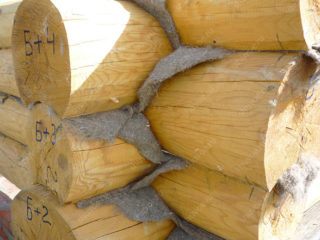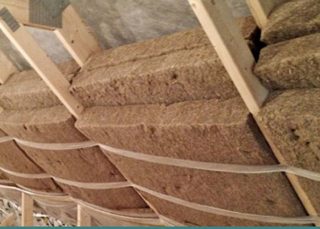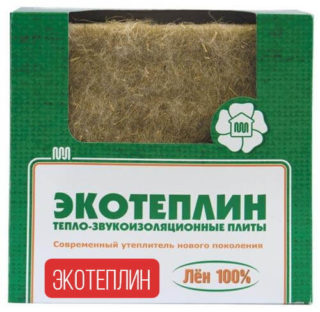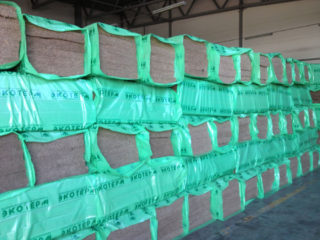The construction industry is looking for non-toxic thermal insulation materials that can provide the most favorable indoor climate. Natural non-woven linen insulation, which has high performance characteristics, has excellent prospects for use in the environmentally friendly construction of residential buildings as an alternative to chemical thermal insulators.
Pros and cons of flax insulation
Flax is a natural antiseptic. This crop is grown without pesticides. Thermal insulation material creates an environment that is harmful to bacteria, fungi and spores, repels rodents. Flax is able to weaken the effects of a chemically harmful environment, lower the level of electromagnetic radiation and radiation. No special disposal required.
Flax fiber based thermal insulation:
- saves heat no worse than fiberglass or mineral wool, eliminates the formation of cold bridges;
- possesses high soundproofing characteristics;
- not subject to decay, does not mold;
- helps maintain a stable temperature inside the building, provides an appropriate level of protection in winter cold, reduces the need for cooling and air conditioning in the summer heat;
- does not dust, does not crumble, does not emit harmful substances and unpleasant odors; on the contrary, it functions as a filter, cleans the air in the room, absorbs odors;
- does not cause allergies;
- due to its high vapor permeability, it protects surfaces from condensation.
The main disadvantage of linen thermal insulation is its high combustibility. Therefore, the material undergoes special processing to protect against fire. The next negative point is water permeability. Flax fiber absorbs water well. However, it dries quickly and takes on its previous shape without losing its heat and sound insulation properties.
When used in places with high humidity, flax insulation needs waterproofing. Thermal insulation structures must be well ventilated.
Release form
Linen heaters in the form of plates and rolls are produced by thermal bonding - bonding of natural fiber at high temperatures and processing for fire resistance. Plates are used for thermal and sound insulation of wall, ceiling and roof structures. Dense and homogeneous linen ribbons - for warming interventional joints and gaps between logs.
Flax insulation is also available in the form of felt - by weaving fibers; batting - needle-punched method, flax fiber is quilted with kapron threads; tow tow - by combing fiber.
Technical specifications and scope
The thermal conductivity of flax insulation on the market of insulation materials is from 0.036 to 0.042 W / m * K. Sound absorption coefficient - 0.98. Density - 20-35 kg / m3.
The thickness of the linen plate is 50/100 mm, length - 1000-1200 mm, width - 600 mm. The thickness of the roll insulation is 5 cm. The combustibility group of popular linen materials is G 3. The service life guaranteed by manufacturers is 60-70 years.
Flax-based insulation is used as a heat and sound insulation coating for horizontal, vertical and inclined surfaces - walls, partitions, ceilings, ventilated pitched roofs - in low-rise building structures. Ideal for internal and external insulation of houses made of timber, logs, frame buildings.
Using roll material, batting or linen tow, you can caulk the inter-crown joints, cracks and cracks, it is easy to insulate the window and doorway. Thermal insulation based on natural fiber is recommended for use in residential buildings, in children's and medical institutions.
Popular brands
Premium thermal insulation materials are in high demand:
- Ecoteplin;
- Termolen;
- Ecotherm;
- Ekolen.
All of them are environmentally friendly, do not contain phenol-formaldehyde compounds, do not emit harmful substances. They have a high degree of thermal protection, regulate temperature and humidity, create coziness and comfort in residential buildings.
Ecoteplin
Insulation of flax Ecoteplin is produced by the Russian insulation materials factory Thermodom. The technology of the German company Flaxhouse is used. Heat-insulating linen mats 50 and 100 mm thick with a foil backing do not contain chemical composites. The binder component is starch. Plates are not subject to shrinkage, are not deformed. Warming does not need vapor barrier. Thermal conductivity 0.038 - 0.04 W / m * K.
100% natural Ecoteplin is not without flaws. This is a low fire resistance and a relatively high price. For fire protection, a drill is used. Financial costs will be justified over time, since there will be no need to use heating appliances.
Termolen
Flax intervent and wall insulation Termolen (rolled and slabs) are produced by the Russian Flax-Jute Company. As a binder, a low-melting bicomponent fiber (synthetic winterizer) is used, which increases the elasticity, resistance and volume of the material. The unique technology of fiber arrangement provides additional elasticity, creating the effect of a spring.
50 mm thick plates are manufactured using thermal bonding technology. Thermal conductivity: 0.036-0042 W / m * K. Natural insulation from flax provides a high level of thermal protection and noise absorption, creates a healthy climate in a wooden house. A rolled tape with a uniform shape and density provides a minimum thickness of the insulation layer.
Ecotherm
Thermal insulation Ecotherm is produced in the Republic of Belarus. Available in the form of linen boards with a thickness of 50 and 100 mm. As a binder component, the manufacturer uses an environmentally friendly polyester fiber, which gives the natural material elasticity, high density, resistance to deformation and shrinkage. Due to the vertical and horizontal arrangement of flax fibers, Ecotherm does not cake and retains its shape for a long time.
Ecotherm thermal plates are designed for heat and sound insulation inside residential premises. Mounted without additional hardware. Thermal conductivity: 0.038-0.04 W / m * K.
Ekolen
Smolensk company Ekolen produces insulation flax batting (needle-punched technology) without the use of composites. A perfectly flat surface of linen batting allows you to abandon the internal wall cladding in wooden houses.
Linen insulation material provides easy installation. You can work with it without protective gloves. It does not irritate the skin, eyes and respiratory tract. Has a Russian certificate of conformity of those. regulations, meets fire safety requirements and sanitary standards. Recommended for low-rise construction.







